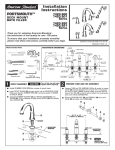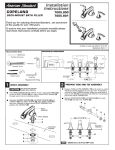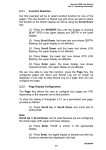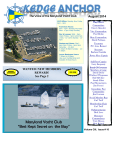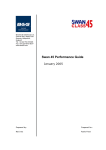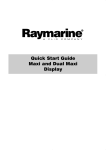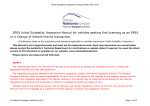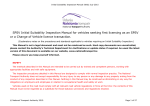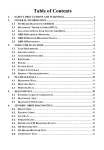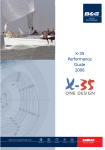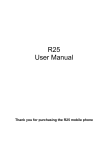Download Junior Chessie Racing J105 operation manual
Transcript
Chessie Jr. Racing Manual: Big Boat Crew Positions The purpose of JBBS is to teach big boat sailing, to junior sailors 14 to 18 years old and to keep our juniors in a sailing programs. Each junior crewmember will have the opportunity to learn each of the 5 or 6 positions in crewing on a boat of size. We are very pleased to have a new big boat coach with years of experience sailing on big boats. Jesse Gaylord has been hired to give a professional hand on assistance for the big boat training. After a while there will be two crews an A and B crew. Those that want to learn and be a part of an active advanced Crew will be placed on the A crew. There is more attention placed on teamwork and knowledge to make the boat perform well. Later on when ready, to learn about working with spinnaker and let the fun began! The B crew will be start up sailors on big boat sailing using just the main and furling Genoa. Playing some music in a very relaxed setting while switching this crew around. On the wheel, main trim, Genoa trimmers, runners, mast, some is looking for wind and other boats or marks. Learning to walk around on the deck always one hand on the boat. All crew’s members to learn man over board drills actually under sail and all aspects of sailing safety. Learning basic navigation with charts, compass, and ruler and later on the GPS units for both crews. The emphasis is on sailing, not on racing, but maybe raising their interest to want to learn the sport of competitive big boat sailing. Helmsman Position It may not take much to sit behind the helm of a yacht or dinghy and steer perfectly to a bearing or to keep the telltales flying straight back. However, there are many distinct elements of racing that a helmsman must absorb and take into consideration during a race. A helmsman must be understanding of his or her crew, think comprehensively, know the fundamentals and rules of racing, maintain a continuous communication with the cockpit, as well as undertake a few important responsibilities on the boat. Having an understanding position with your crew is extremely important. Patience is vital between helmsman and crew because commonly a helmsman can become fed up when a job is not being done fast enough by a certain crewmember and yelling will occur. Yelling commands will absolutely not get a job done any faster. More than likely, crewmembers will lose assurance in them if singled out and yelled at by anyone, and may possibly proceed in a non-confident manner throughout the rest of the race. This will only slow things down more. Having a confident and calm boat helps things run along very smoothly. Learning all the positions on a boat or having experience in a few areas helps an exorbitant amount with this aspect of understanding and communicating when things need to be done. Furthermore, as a helmsman, there are certain points in the race, perhaps during tacking, mark rounding, hoists, or douses, when your eyes are focused on the crew. This is an excellent time when knowing different positions on the boat comes in handy. Being able to spot possible mishaps or fouls before they happen is very important during racing, and having an extra set of eyes on everything may help out huge during a tight race. It is vital that a helmsman thinks things through and as far advanced as possible while racing. Comprehensive thinking is one of the most important aspects of a consistent and cautious helmsman. The ability to take what has happened, what is happening now, and know what might happen in the future is a huge factor of success. The major part of comprehensive thinking is anticipation. The capability to think ahead during racing and especially at the start is key to a cautious tactical routine. With anticipation, you must constantly ask questions to yourself. For example, if it were a shifty day and you were planning your start routine, while taking into consideration which side of the line is favored and where you would like to start, you must ask yourself questions like: Will I be able to tack if the wind suddenly shifts? Many of these questions you will ask yourself come from past experiences, usually bad experiences that you have learned from. However, many aspects of anticipation come from boat handling. This is where practice comes in of coarse. Knowing how long your boat will take to accelerate or decelerate is extremely important. Having a good feel for the boat is probably the most important skill a helmsman must have because if he or she is sailing with a skilled crew, many tactical questions will be answered. Having a good feel for the boat does not necessarily have to do only with steering and boat speed, but also knowing how long certain jobs on the boat take, such as sail changes, douses, trimming for a mark rounding, etc. But again, boat handling does not come naturally, and it takes a lot of practice to reach a comfortable feeling with most boats. A helmsman must be very conscious and responsive to everything that can make the boat go around the coarse fastest. This is all part of the fundamentals of racing. A few things that must always be crossing a helmsman’s head while racing are: Where is the rest of the fleet? How can we make the boat go faster? Where are the most breezes on the course? What is the wind direction doing? What is the current doing? Any possible way that may speed up the boat or get around a course faster while covering or staying with the fleet is crucial to a consistent and successful race. A helmsman must always know the rules of racing as well. It is so important that a helmsman 7 can act as soon as possible and not waste a second thinking about a rule throughout the race, especially at the start. It is vital that a helmsman is confident with the rule to avoid being pushed around at the start. Many times a less experienced helmsman will be shot out by older or more experienced helmsman and will not be aggressive because the other boats are yelling random rules. Knowing the rules allows you to know exactly what your boundaries are. The start is all about timing, tactics, and most importantly knowing the rules. Communication is very important with the helmsman and sail trimmers. In heavy breeze, the helmsman must constantly talk to the main trimmer and have a relaying conversation if there is too much resistance on the helm or if the main could be powered back up if there is a lull. It is very important not to have too much helm to avoid creating an underwater break with the rudder’s resistance. Furthermore, in light air going down wind, it is essential to communicate with the spinnaker trimmer to ensure that there is enough pressure for the spinnaker. So in general, it is vital to communicate with your crew to make sure that things are being done when or if needed. Communication is extremely important to keep a crew working as a team and to keep the boat going as fast as possible. A helmsman primarily has one of the least physical and safest jobs on the boat, not to mention a position of leadership. Therefore, the helmsman must ensure that his or her crew is keeping safety as their first concern. Behind the helm of a boat, it is vital to make sure that everyone is prepared to do anything before any action takes place. Before every tack, jibe, rounding, or basically any motion of the helm, a loud “Ready?” is very important. It is also up to the helmsman that everyone confirms, “ready,” or something along those lines to double check and make certain that everyone is in fact ready. The man-over-board (MOB) drill is another extremely important aspect of safety that a helmsman must take into consideration. We are dealing with people’s lives here. Sailing does not seem like the most dangerous sport, but even the finest professionals have a mix up and lose a life. Thus, it is imperative in extreme weather or winds to quickly run over the MOB drill with the crew and go over the process in case something were to happen. You can never be too safe. Of coarse there are more things that go into what makes a consistent and talented helmsman, but many of the skills come from experience. Not necessarily skipper experience, but experience out on boats, with big fleets, small fleets, or even just on a Sunday afternoon joy ride. Being out on the water and sailing you can pick up little tips, whether it is experimenting with something or just learning from mistakes. The most important aspect of a helmsman on any day though is boat handling. Getting a feel and rhythm down on a boat is the most basic and important job of a helmsman. Using the least amount of rudder while flying the telltales or working the waves if it is a wavy day is the only thing a helmsman can do to make the boat go faster. It is extremely important, therefore, that you practice to achieve a confident and relaxed feel for any boat that you are behind the helm in a race. Chris Filiberto College freshman Teamwork All Positions Teamwork on a big boat is very important for the success of boat performance. We find that there is eight crew positions to be filled, a few by more then one crewmember. There are quite a few situations where several positions have to work in concert to perform a maneuver. Other times the helmsman and trimmers perform the task until a tack is called for! When a boat is sailing up wind after the start three crew members work together to make boat sail as fast as possible. The rest of the crew generally sits on the high side of the rail. That's when the wind is about five knots or more. Under that wind speed crew could be switched to midboat or on the lower rail. If one crewmember calls out hold, everyone must stop. Someone may see a crewmember in trouble or some other important malfunction. This problem must be ID as soon as possible, and cleared quickly. When tact is called for the foredeck person moves to the mast and grabs the released sheet and assisted the Genoa over to the new tack. The rest of the crew moves to the other side of the boat. In the cockpit the helmsman turns the boat over to the new tack. The main trimmer resets the mainsheet traveler car and retrims the main sheet. Two crewmembers on the Genoa separate one stays on the high side to release the old Genoa sheet. The other starts to pull the new Genoa sheet over to the new side. By then the other trimmer is back on the new side and grinds in the new sheet. One crew tailing the other grinding. The runner person releases the old high side runner sheet and moves to the new high side and sets that runner sheet. That's about six crewmembers that have different position to perform one task, plus the rest of the crew moving to the other side of the boat. This an example of team works! Helmsman, Foredeck, Mast, Main, Pit, Genoa, Runner, Skipper, with 3 at the mast, 2 Genoa trimmers Minim crew Mr. L 8 Foredeck Position The foredeck is the eyes of the boat. Being in the foredeck position requires you to work with and to lead the actions of the boat. It is important to keep strong communication between the front of the boat and the back of the boat, particularly with the mast people, pit and the skipper/Helmsman. When preparing to sail, the foredeck is responsible for preparing halyards for hoisting sails and making sure they run clear. If a spinnaker will be used, the guys and sheets for the spinnaker must be run and ready to be used. Part of this is to work with the mast people to attach the spinnaker pole to the mast. Before departing it is a good time to be sure all lines run free and that you are aware of where particular lines and halyards are incase of a fast pace procedure. Before leaving you also should discuss with the crew and skipper what types of sails may be used and to prepare what ever will be first. The departing from the mooring or dock is also part of the foredecks job. When hoisting sails it is important to have halyards clear and to work with the mast men. Communication between the two positions is key. Be sure to attach the corresponding jib halyard with the right track on the forestay incase of a jib peel. When hoisting a jib, a steady pace is important to keep the sail in the track. When hoisting you should remain on the foredeck guiding the sail between your hands as it enters the forestay track. During tacks you must pay attention to the jib and be sure that it is inside the lifelines and has a good flow, this is called skirting the jib. When hoisting a spinnaker you must be in constant communication with the pit person, the skipper and the mast people. First the spinnaker should be brought on deck. Tie the bag to the rail and leave the spinnaker in the bag while attaching the port and starboard sheets and guys to the clues of the sail. Then depending on which side the hoist is taking place attaches the appropriate halyard. Before hoisting the spinnaker the spinnaker pole must be attached to the toping left where as then you lift the pole with your hand allowing the pit person to take the slack up. When the hoist is about to take place and the skipper gives the command for the mast people to take up the halyard, sit on the deck with your arms wrapped around the spinnaker so that it does not fill before the mast men can get it fully hoisted. When the hoist is complete quickly and efficiently take down the jib. When taking a jib down the mast person releases it at a good pace while a few people quickly flake it. The foredeck person should be at the very front of the bow pulling hard so that the others can follow their lead for flakes. When possible get as many people off the bow as possible. Release the jib from the front of the boat and either put it in a bag if it will not be used again or fold it back once and tie it down so that it will not be in the way incase you have to jibe. While the spinnaker is up a jibe may be required. During this take lots of slack in the lazy guy and walk it to the bow. Before anything the mast people will raise the inboard end of the pole to a particular point. When the boat is squared the skipper will yell, "trip." At this time the mast people will have tripped the pole (opened the front jaws) releasing the old guy and the pit person will lower the topping lift dropping the outboard end down to the deck. You then take the outboard end and put in under the forestay to the other side then put the new guy into the jaws and push down so they close. After this is complete you yell "made" and help push the pole up with your hand while the pit person takes up the toping lift with the mast people also helping to jump the topping lift at the mast. When preparing to take down the spinnaker first reattach the jib and hoist it. Take the lazy guy and pull it under the jib with the help of the mast people. The pit person will be down the forward hatch prepared to pull the spinnaker down below. At the command of the skipper the halyard is dropped about 10 feet gathered quickly and then the remaining halyard is dropped at a steady but quick pace and gathered. It is important that the gathering be done quickly so that the sail does not go into the water, which can cause problems if it gets stuck under the boat. When cleaning up the boat it is the foredeck person’s job to put all halyards back into the correct position, take the spinnaker pole off and to help with other spinnaker gear. The foredeck is a position that helps connect many other positions on the boat. It is important to be alert and to listen to what is going on around you and to always be prepared for changes. The foredeck is a fast pace position with many dangers but also with the most rewards. The flow of the boat is important and communication is key so that all maneuvers can be completed successfully. Allison Madia High School Junior MAST POSITION The mast position you'll find it fun and at times exciting, seldom boring. There are about seven crew positions on a competitive racing Yacht (yacht is 40 ft plus). The position at the mast is one of them. The minim number of people is two, three is better when the halyard is used to raise a racing sail. One/two crewmembers to pull the sail up and another to tail the halyard. The tailor must keep two raps on the wench, and to quickly take up all the new slack from the raising halyard. Once the halyard is about all the way up the tailor will put 9 two more wraps on the wench to grind it up a bit more! The new excess halyard line is neatly coiled and placed on the wench. The crew raising the halyard must keep their eye on the Foredeck person. If there becomes a problem (like the sail jumps out of the feeder) they must stop and lower the halyard so it can be refed into the sail feeder. Care must be taken so this doesn't happen. Races are won by seconds. The sails must get up as fast as possible, but under control at all times. When change sails, the tailor must be sure to uncoil the halyard so it doesn't jam in a shev. When dropping a spinnaker care must be taken to drop as much sail as the crew can quickly handle--never let the halyard run free! When first dropping the spin halyard let about fifteen feet go, after the keep it under control. A spinnaker under the boat can ruin the whole day. When dropping a Genoa, this can be done much faster as it generally will fall on to the deck. But never let any halyard run free! Again, keep an eye on the Foredeck person. If some can go wrong it generally will. When the skipper or helmsman calls for sail change the mast people well quickly go bellow and bring up the new sail. The Genoa are big requiring two people to carry. Generally when there is going to spinnaker call the Foredeck person will get it. But everyone will always help an other crew member. When a Genoa is dropped on the deck it must be flaked (folded) and put into a turtle (a long bag with a zipper). So if the wind increase or decrease and new Genoa is called for we are ready for a change. When flying a spinnaker the mast people are again called on when jibbing the shoot. They get their clues from the Foredeck person. The pole must be raised at the mast end to a black band on the mast. This is so the pole can be dipped past the head stay. Then watching the Foredeck person, the pole is readjusted (generally down) to where it was before the jibe. The topping lift is used raised by helping the pit person get the pole back where it was before the jibe. When tacking a Genoa a mast person should help the sail passed around the mast. Caution here to keep you’re selffree and not in danger of getting tangled into sheets or sail. Other then a couple smaller thing you'll get to set on the rail watching for boats, new wind and any information the skipper might need to know. Harry Penkoff High School Sophomore PIT/RUNNERS The pit person is critical in spinnaker handling. This is generally found in the companionway area. Here this crewmember is in position to change of the fore guy and topping lift. The fore guy line is attached to the front of the spinnaker pole to blocks attached to the fore deck. The line (fore guy) runs from the pole through the block on the fore deck to wench near the companionway. This line holds the pole from go up when the spinnaker is flying. The topping lift line is attached to a medal cable ring on the spinnaker pole. The topping lift line runs from the top of the pole up to about 3/4 up the mast, then down the mast to a block on the deck near the mast. From this block back to another wench near the companionway. This line controls the raising or lowering the pole. Handling the pit gets to be a very busy and very important position. When the spinnaker (chute) is about to be raised, the pole is lifted by the topping lift and the fore guy aids in keeping the pole stable. When the chute is being trimmed the fore guy is trimmed as well, allowing the pole to move more forward or backward. If the pit person is not paying attention the spinnaker pole could travel straight up the mast. When jibbing the chute the fore guy has to allow the foredeck person to guide the pole towards the center of the boat. The mast person slides the pole up to a black mark on the mast. The topping lift lets the pole down to the foredeck person who brings the pole around the head stay to compete the jibe. Once the foredeck person yells "Made!" the pole is raised back to where it was on the last tack, give or take a little. The fore guy has to be trimmed and off we go. Having fun yet! When the chute is to be dropped the fore guy is given out some slack. Then the pit person goes below deck to the forward hatch, opens it (thus the name the pit). The pit person pulls down the chute, with the help of crew on the foredeck, into the open hatch. If you could imagine, there is a lot of excitement getting the whole spinnaker into the hatch. Once down below deck all the spinnaker lines are to be removed and kept up on deck and the hatch is closed. Once the chute is safe down below, the massive sail has to be re-packed with the help of one of the mast people. It's important that the spinnaker is packed the right way in order to prevent any hourglasses or other mishaps the next time the sail is used. To pack the spinnaker, one person ties the head of the sail to something that won't move, such as the stairwell. Along each side of the head is a red or green tape that both lead to a clew. One person runs their hands along the red tape and the other person runs their hands along the green tape. This prevents any twists from occurring the next time the chute is hoisted. Once both clews are reached, they are brought together with the head of 10 the sail and all three corners are tied together, and then tied again to the stairwell. Now the fun part! One person takes the spinnaker bag and holds it open while the other person stuffs the rest of the sail in to it. In the end, the head and both clews that were previously tied to the stairwell are tied or clipped onto a tie on the spinnaker bag. At that time the chute is packed and ready to go. The Pit person has the responsibility when the boat is on the wind to manage the runners/check stays sheets. When the wind is light to medium to tighten the runner/check stays rather tight on the secondary wench. When the wind builds the runners/check stays are pulled tighter, when the wind get up to 28+ knots and higher the runner/check stays are pulled very tight--careful not to cause a negative mast bend (that's when the top of the mast bend forward) that is dangerous and could lead to serious mast damage! The mast person should be reminding the mast person to look up the mast to check for negative mast bend. When tacking it is important the pit person releases the runner/check stay. Usually a jib trimmer will set the new runner/check stay sheet on the new side wench. Then the pit person takes over to set it at the right tightness on the new tack. If the pit person is slow at releasing the sheet could end up on the wrong side of the boom and wont let the main sails tack over. Off the wind the runner/check are of little importance and are to be kept out of the way as possible. Overall, although the pit person does not drive the boat, handle the foredeck, trim the jib, etc, the pit person is always running around and doing something, whether it be managing the runners/check stays sheets, trimming the fore guy, raising or releasing the pole, or, of course, packing the chute. Stephanie Voucas High School Junior Main Sail Position Operating the main sail is a very an important team position. In racing the main trimmer have several things to think and be aware of. The mainsheet and mainsheet traveler are the primary diving force. Backstay or mast bend are set depending point of sail, on the wind, reaching or down wind. On the wind is when the most attention is paid to the mast bend. Wind seed or force greatly effects boats heal. The higher the wind force the more back stay pressure and the more the top of the main losses effects performance. Also the main traveler moves away or down from the wind on the sail. This helps the boat to sail with less heal and more importantly the helmsman well have less weather-helm. Weather-helm is when the rudder is over some and acts as a break to forward speed. The helmsman will in inform the trimmers of what he is experiencing. As the main trimmer lets the traveler be eased along with some main sheet being eased weather-helm and heal will be lessened. This only happens in heavy wind. Again sailing up wind in most wind speeds the main traveler is used to bring the boom even with center boat and is changed after each tact. Also is very important when flying a spinnaker and then is to be jibed over to a new tack. The main is now being jibed not tacked. The main will be filled with air or force and the mainsheet and traveler must be pulled into center boat before the jibe is competed. After the jibe is competed both the mail sheet and traveler must be reset on the course. If this isn't done, the main and boom when will come across the cockpit with great dangerous force. The effects of runner/check stays on the main are discussed under the pit position. They do affect the main performance. As the race continues the main halyard relaxes so the trimmer may tighten the luff of the main by use of the Cunningham line. This is a line that travels from the cockpit to the base of the mast, through a block and is attached to a grommet in the main sail. This line when pulled by the main trimmer tightens the Luff of the main. Out-haul is a line from the cockpit to the base of the mast through a block and up to the boom. It travels in side the boom to the other end and attached to a cable through a shev at the end of the boom and attached to leach end of the sail. When the boat is sailing up wind, this line is pulled tight, pulling the whole sail back. Pulling the foot tight and taking the pocket out, the sail is now tight back. When sailing on reaches or running this line is loosened and the pocket on the foot opens to make the main fuller. Again it’s the main trimmer response-ability. Leach line runs inside and down the sail leach. There are times the mails leach will vibrate by pull the leach line a bit tighter the vibration is stopped. The sails foot also has foot line (on a loose footed main), which can be adjusted also. Trimming the main sail. This sail gives the boat about 40% of speed and power. This sail has 4 battens at the end of the battens are attached red telltales. All 4 of these battens should be flying most of the time. Using the mainsheet, traveler sheet, out-haul, Cunningham, backstay pressure, main halyard and runners/check stays the main is trimmed. 11 A point on main halyard, there is a black mark at the top of the mast; the sail should be pulled up to not over that mark. When the main is dropped on to the boom, it must be flaked and tided to the boom with about 5 tie-ties and cover put on again. There is a great need for a special kind of teamwork between the helmsman, the trimmer of the main and Genoa. When flying the spinnaker, only the new names of the trimmer change to spinnaker trimmer and guy trimmers. Julie Lelek College Sophomore Genoa Jib Trimming Position Genoa jib trimmer have 3 different Kevlar weight racing Genoa's. The light/medium # one used from 0 to about 8 to 10 knots of wind, the heavy # 1 from 10 to 17 to 18 knots of wind, after that the # 3. Two Genoa tracks in board and out and the cars are set for the different Genoese and just one for the #3.Two people are needed to tack the Genoa's, one to grind one to tail, after that one person to tune. When sailing up wind, attention must placed on tuning the runners. Work between the helmsman, main and Genoa trimmers. In trimming the Genoa jib on a headsail boat is very important as most of the power and speed comes from this sail. Along with power and speed this position can require much strength and endurance. A especially when the boat may be in a tacking duel with another yacht. Once the sail is been pulled in after the tact one person can trim it. This person must be watching the different tell tails to be sure the telltales on both sides of the sail are flying evenly or parallel. If the telltales on the in of the sail are going up the helmsman is sailing to high or close to the wind. If the out side telltales are flying up, the trimmer should trim the sail in. Now these are general statements. There maybe times the helmsman may need to come up for reason and should inform the trimmer. Like wise may need more power to drive through a big wave, so he full off course a little. But he must tell both the main and jib trimmer what he is doing. Over trimming a sail can slow the boat down so trimming should generally done in inches. Remember a big boats when it losses speed can take several seconds to minutes to regain boats speed. Setting jib cars. On the deck there are tracks and the jib sheets are lead through cars on these tracks. These cars carry great amounts of pressures and cannot be moved. Where these cars are set controls the set of the jib or proper sail conformation. If when you are flying the jib and the top of the sail is luffing (no tight) the jib car must be moved forward and back if the lower part is luffing the car most be moved back. Usually done on the track not being done on the high side, then tacking. Should be done before the race starts. Using the right sail for the speed of wind is very important, wind speeds change often in a race. The helmsman generally will feel the boat handling difference as the wind speed changes. Wind will change often so the best sail for the overall will be the one to try to stick with. Example the speed increased and we where using the light, we could no longer point high and the boat was hard to handle. We did a charge to the heavy and it was like a new boat, point high again regained full control of the boat. Some times a jib peal needs to be done. That's where a jib is changed while on the same tack. It requires teamwork and great care must taken that no one is injured. The trick is that the aluminum foil on the head stay empty side is on the out side. Otherwise the new jib will be raised on the in side making it very hard to lower the old jib. Best would be to tack over which can get the jib sheets a bit confusing. This is best done with a trained crew. Furling jibs are trimmed much as the racing sails. The major difference is the sail maker has to take in consideration that this sail has to be furled around the head stay. So generally the boat wouldn't sail as close to the wind. The boat will sail fairly well. You can reef the sail by rolling in a bit to cut down sail area. They designed for easy of handling, not race performance. The only trick is when pulling in or furling in this sail, one person should keep a little light tension on high side sheet. Thus, the sail will furl in tightly. Usually one of the trimmers well controls the guy sheet for the spinnaker. The guy sheet is always kept on a big wench. The guy controls the spinnaker poll and must keep the poll away from the head stay. If the other jib trimmer is the best person to fly the spinnaker, then he/she will fly it. The spinnaker sheet can be put on a secondary wench. When the winds get around 5 knots a person will be needed on the wench. 12 Meredith Waldron College sophomore Big Boat Skipper One of the most exhilarating experiences someone can have racing sailboats is being the skipper of a big boat. So, what does it actually mean to be a skipper? To explain the role of the skipper we will use look at our perfect model, Alex (coincidently a gender neutral name). On a dinghy the skipper is the driver, but we should be careful not to confuse the two jobs. Sometimes the skipper is the helmsman, but in our case the skipper, Alex, is not on the wheel. First and foremost, Alex is the team leader. Lets first talk about leading a team, specifically a team of sailboat racers. Alex has assembled an all-star crew, all with successful racing backgrounds. Everyone wants to win and they all have different ideas on how to accomplish this. It is important for the skipper to assert himself or herself as the person in charge and a person that a team will want to follow. This does not mean that the skipper should take the megaphone and start baking orders from the transom. Here are a few thoughts of how a skipper may assert themselves as the respected leader of the boat: Be the first person on the boat the day of the race and start getting the boat ready. This might mean coiling lines, scrubbing the waterline, pumping out the head or making sandwiches for lunch. This shows the crew that you are excited to be there, but more importantly it shows that you are willing to do any of the jobs (even the crappy ones) that you will have to ask them to do. Another way for a skipper to gain the respect of a rock star crew is to show proficiency in every job on the boat. This does not mean that the skipper has to be the fastest grinder or the quickest bowman, but a skipper must know how to do every job on the boat and show the crew that. Finally, the skipper gives the orders (not with the megaphone) and takes responsibility for them. This can begin before the race and be as simple as calling the crew and letting them know what time to be on the boat. It always means leading a pre-race meeting where last minute crew assignments, weather, courses, and tides are discussed. During the race it means that all decisions (tack, jibe, cross, duck, etc.) are ultimately made by the skipper – democracy on a big boat never really works because its too slow to throw the anchor over and vote if we should tack or not. After a race let the trimmers take a break and do their job for them, or help flake a sail. Our model skipper Alex has done all these things and shaped our group of sometimes rowdy and individualistic rock star sailors into a cohesive, fast team. What might have been the outcome is Alex had been the last person on the boat every day and refused to do anything? Mac, our big man on the mast, who had beat Alex in the last 3 Finn Olympic trails might have questioned his decisions and cause the crew to doubt Alex’s abilities. Since Alex is perfect, these mistakes were not made and Alex is able to lead an excellent racing crew. Even the best skippers will make mistakes, a good crew knows this, but the crew must trust the skipper. So, the skipper can never relax. Alex always looks out for the crew’s safety, the boat’s safety and of course winning the race. The skipper must effectively organize to make the boat fast. The organization will ultimately depend on the boat and the crew, but here is a rough guide with a sizable crew of 12. The back of the boat has the skipper, helmsman and navigator/tactician. The skipper stands behind the helmsman to facilitate quick communication and oversight of the entire boat. The navigator/tactician is also on the transom, but sometimes ends up standing in the pit to look around while being able to run to the Nav station without get in the way of all the trimmers. The cockpit has a main trimmer, two jib trimmers two grinders and a pit person. The mast and bow have a total of four: a bow captain who organizes and does random things, the actual bowman, a jumper (who will become a grinder) and a tailer. The mast and bow team are under the control of the bow captain who talks with the skipper. Now that we have established the importance of leadership, lets take a look at the actual mechanics of being a big boat skipper. First pretend you are the President of the United States, you could not possibly attempt to be an expert on everything, so you have advisors. You have economic, military, agricultural advisors and so forth. The key here is to trust your advisors, listen to them and then make you own decision. The worst-case scenario is micromanagement; by this we mean trying to be an expert on everything and making every little decision. So how does this example related to our big boat? The skipper must be able to simultaneously receive many elements of information, disseminate them and make a decision based on the information. So what are our major sources of information? Our crewmembers, instruments and the skipper’s own senses. Ok, lets talk for a little about how a skipper should think about how to process mass quantities of information. First we need to figure out who we will talk with and when. There are many ways to run crew communication; here are a couple of ideas. First encourage communication but don’t make it so everyone on the rail is turning around telling you about the same puff. The three primary elements are the helmsman, navigator/tactician and the trimmers. All three will communicate with the skipper constantly. The bow captain is secondary. The skipper and the helmsman need to be in constant communication. For example the dialogue may be something like this: Helm-“boat still feels slow with the chop”…. Skipper- “Ok, come down 5 degrees”…. Helm“Better”…Skipper-“Ok, don’t come done any more, bring it up when you have the speed” 13 The other key player who the skipper will talk to the entire race is the navigator/tactician. The N/T is particularly important before the race. Talk to the N/T first about what the heck the course is going to be (there is nothing more embarrassing in big boat sailing than going to the wrong mark, especially when you are in first). Plot it on the GPS and redo it on a chart with a pencil in case the GPS craps out. Second, the skipper and the N/T need to nail down what the strategy for the race is going to be from start to finish. To formulate this strategy the skipper will talk over the data the N/T has gathered such as currents, weather forecasts, and the recorded changes in wind velocity for the day, etc. During the race the N/T will update the skipper with this information as it changes, but it is key to get the N/T out of the Nav station during the race so that he can help the skipper with tactics during the race so that their strategy can be executed. The third group is your trimmers. Don’t try and micromanage. A well trained crew will know what is going on so don’t try to give orders to the loaded trimmer and the same time prepare the off trimmer for the next tack and ask the main trimmer a question. Here is a good way to think of talking to trimmers: only talk to two people, the most import first. The most important being determined by the size of the sail or immediate task. So if your boat has a relatively small mail sail, the skipper should generally talk to the jib trimmer first. But if we are trying to make a windward mark and needing to pinch, talk to the main trimmer first. Dialogue might be: Skipper“we need height, traveler up 3 inches…bring the jib to the spreader” Likewise, when the spinnaker is up always talk to the chute sheet trimmer first. With the spinnaker the dialogue will be all about the pressure on the sheet. Finally the secondary group is the bow (by secondary we don’t mean less important, but there is no need for constant communicating the entire race. The folks in the cockpit generally have a good idea what is going on and are able to execute a changing barrage of commands from the after-guard but often times the bow is a bit slower. This is the fault of the after-guard, not the bow. Since those guys are far forward they don’t always hear the conversations in the back of the boat. Also, some skippers have unrealistic expectation of their bow people. For example skipper will call for a jibe set 40 seconds before the mark and the bow guys will scramble to switch the gear and then the skipper will decide at 5 seconds to round that it will be a bear away set. This scenario can be seen on the PHRF courses and is always disaster. The skipper must talk before the race about the bow crew’s capabilities with the bow captain to know what is possible. Going into the windward mark, it is the skipper’s job to tell the bow captain what chute will be used and what type of set it is going to be. It is two commands from the skipper to the bow captain. Going downwind the skipper will make the decision as to what jib to used going upwind a tell the bow captain with enough time for him to get a sail below deck and bring another up. If something on the bow gets fouled up at the last minute, the bow captain is the one who will yell back to the skipper and explain what the deal is. The bowman (not the bow captain) will only directly communicate with the back of the boat in the middle of a jibe. It is important to for the skipper have a competent and strong leader with a loud voice as the bow captain. The bow captain must be independent enough to handle all the little problems and manage the bow/mast people without help from the back of the boat. It is too far away and too busy for the skipper to deal with effectively. A key thought here is to trust your crew, but also trust your instruments. Technology will help us accurately determine how fast we are going, how fast we should be going, when we are on a lay line, just to name a few things. Skippers who come up from dinghies sometimes don’t utilize these tools to their potential because instruments were not a part of their dingy racing and they tend to “sail by the seat of their pants.” On the flipside, some big boat skipper become mesmerized by the ever changing numbers in front of them and never look around or “feel the boat.” Alex is able to strike a balance between feeling the boat and looking around, while keeping a check on the instruments and an ear open to the crew’s feedback. With these three major pieces of information, Alex makes the major race decisions for the boat. Alex calls for the tack, Alex calls for the pin start and Alex is the only skipper on the boat and the buck stops there. Even if the skipper does not actually own the boat, the skipper takes the responsibility for her and her crew. A big boat race is a challenge not only of a skipper’s racing ability, but a skipper’s ability to lead a team. Peter Lelek College Junior General Information Runners A lot of attention is to be placed here. Damage to the rig if your tension is relaxed. Particularly in heaver wind when 2500 to 3000 pounds of back stay and the runner line is set on the black mark on the runner sheet. When tacking the runner person is to relaxing the working runner. The new A trimmer must set up runner line for the new tack. Just what job does the runner and check stays perform? A main sail is designed and shaped as if the mast is straight up and 14 centered. When you pull the mast back the shape of the main is less then correct by mast bending. When the wind pulls the sails lowered the mast again is off center. So you tighten the runner/check stays makes the mast straight and centered, thus the main is much more efficient. So more wind, more back stay pressure and runner/check stay tightening. Import to know! You must pay great attention not to pull the middle mast back so the top of the mast bends forward (negative bend). If that's allowed to happen there's a good chance of mast damage. So the center boat captain or the mast person must always check after each tack. The top of the mast should be close to straight up never bending forward or off center. Suggested pressure for the backstay: Wind Speeds 0-5 5 to 10 10 to 13 13 to 16 16 to 18 18 above Backstay tensions Barely just enough so backstay isn't flopping around. 700 pounds 1500 pounds 2000 pounds 2500 pounds 3000 pounds Vang shouldn't be used upwind unless used, only in heavy wind then if done incorrectly the boom could be damaged. Downwind Back Stay it is safe and fast to ease the backstay right off and pull rig forward. In winds 15 plus you can keep a little tension like 1000 pounds on back stay. Down wind Vang used until the upper leech looks correct and record the pressure on a chart. 15










